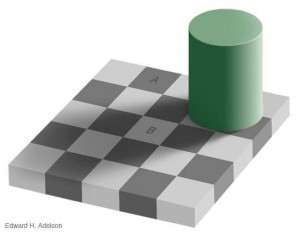How to Frame Your Messages for Persuasive Effect
 In a monastery one time one monk saw another praying with a cigarette in his lips, and said: “What are you doing? You’re not supposed to smoke at prayer.”
In a monastery one time one monk saw another praying with a cigarette in his lips, and said: “What are you doing? You’re not supposed to smoke at prayer.”
The smoker said, “Sure I can, I have permission from the abbot.”
“No way! I asked him if I could smoke when I pray and he said it was forbidden.”
“That’s because you didn’t ask the right question”, the smoker replied. “I asked him if I could pray while I smoke.”
As you can see from this example, the same situation can be viewed entirely differently depending on how it is perceived, and how it is perceived depends on how you frame the message. Effective persuaders know how to frame their message for maximum appeal to the intended persuasion target.
Framing is a way of presenting your message in such a way that listeners see it one way as opposed to another. Just as a photographer chooses which aspects of the subject to highlight, by thinking carefully about how to frame your message, you control which aspects of the situation your listeners should focus on. Carrying the photography analogy further, you choose the angle at which you want to take your picture, which areas to light up, where to focus, and even what else you might want to include in the picture next to your subject. In effect, you are helping your listeners to evaluate your message in a favorable light.
While persuasive communication is heavily dependent on having facts and evidence to support your case, simple recitation of facts is not enough. You add value to those facts by placing them in proper context and helping your audience understand what they mean.
In thinking through this post, I’ve so far thought of twelve different types of frames that a practical persuader can use. It’s too much for one article, so I will cover only one this time and then write about the others over the course of the next few weeks in the full detail they each deserve.
Frame #1: Comparisons
Facts are facts, right? Not really.
Even something as easy to comprehend as color can take on a different meaning depending on how it’s presented. Take a look at this picture:
Which square is darker, A or B?
Believe it or not, they are exactly the same. (For proof, go to http://persci.mit.edu/gallery/checkershadow/proof ) As you can see, even seeing is not believing, because what we perceive is affected by what is around it.
Facts take on meaning only in comparison to other facts, so it’s important to choose the frame of reference your audience will use to evaluate your message. For example, when Jack Welch took over at GE, most divisions were performing well in relation to their industries, so in order to instill a sense of urgency he had to change the benchmark. He challenged business unit heads to be number one or number two in their industry, and suddenly the situation looked much different.
Numbers are particularly susceptible to framing effects. In fact, numbers are essentially meaningless except in comparison with other numbers. When you tell someone how much something will cost, you can make the number seem smaller by telling them how much you could have spent if you had bought the most expensive one. Large numbers are especially difficult for the mind to comprehend. For example, with all the talk about government spending it’s easy to lose sight of just how huge a billion dollars is; but just consider that it would take ten pickup trucks carrying a ton of $100 bills apiece to transport it, or that a person who earns $100,000 per year would have to work for 10,000 years to earn that much.
Numbers can also play tricks in our minds. Consider this scenario: you are buying a $20 calculator, and a passerby informs you that she saw the identical calculator for $15 at a store ten minutes away. What would you do? Now, imagine that you’re buying a flat screen TV for $500, and you find out that the same TV is selling for $495 at a store ten minutes away. What do you in this case? Most people say they would drive ten minutes in the first instance but not in the second. It seems that the value of $5 changes depending on the circumstances.
These simple illustrations show that the context in which you frame your arguments is just as important as the data you present in support. In my next article in this series, we’ll examine the surprising persuasive differences between positive and negative frames.




[…] As Jack Malcom puts it, […]
[…] Jack Malcolm says, “Framing is a way of presenting your message in such a way that listeners see it one way as opposed to another.” […]
[…] Jack Malcolm says, “Framing is a way of presenting your message in such a way that listeners see it one way as opposed to another.” […]